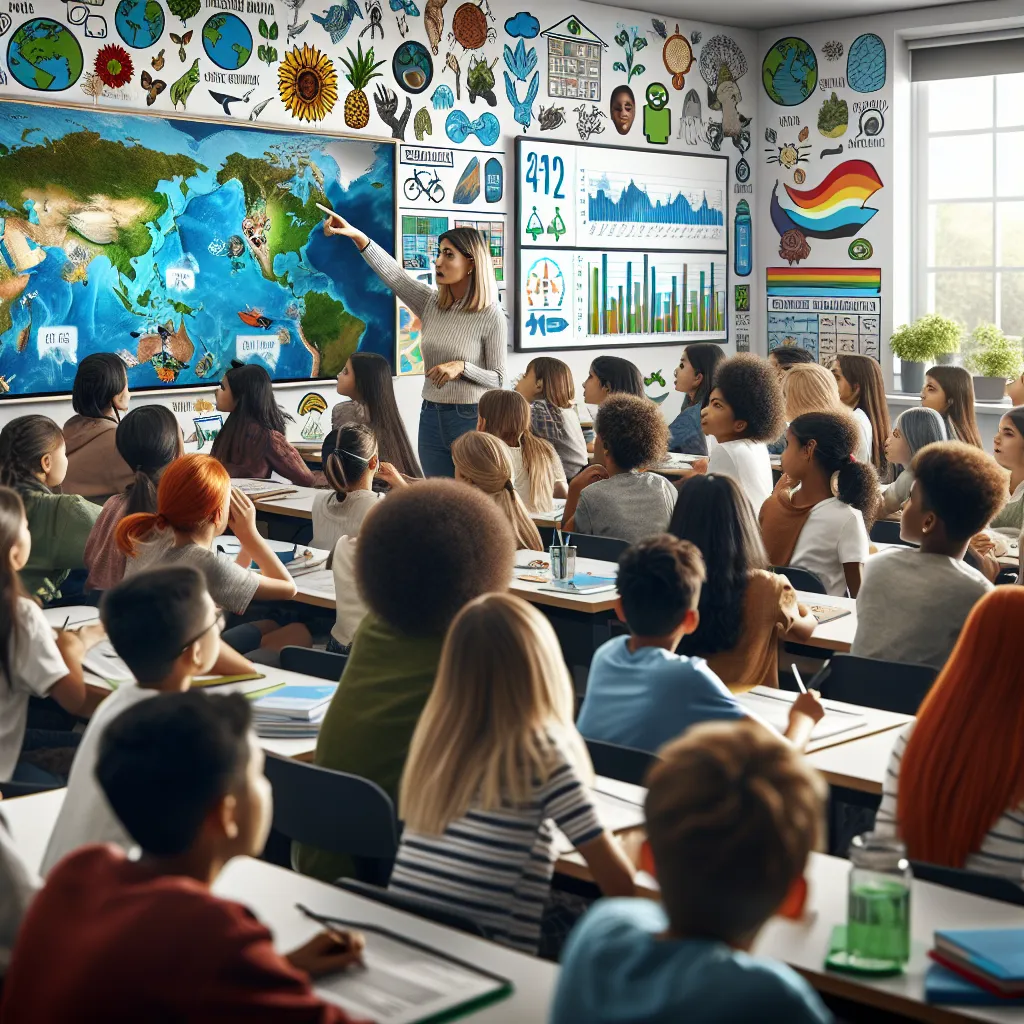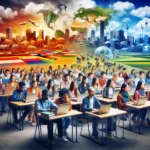In today’s IELTS Reading practice, we’ll explore “The role of education in promoting environmental sustainability.” This topic is increasingly relevant in our modern world, where environmental concerns are at the forefront of global discussions. Let’s dive into a comprehensive IELTS Reading test that will challenge your comprehension skills while providing valuable insights into this crucial subject.
 Environmental Education Classroom
Environmental Education Classroom
IELTS Reading Test
Passage 1 – Easy Text
The Importance of Environmental Education
Environmental education plays a pivotal role in fostering a sustainable future. By integrating environmental topics into curricula at all levels, from primary schools to universities, we can cultivate a generation of environmentally conscious citizens. This approach not only imparts knowledge about ecological systems but also encourages students to develop critical thinking skills and problem-solving abilities in relation to environmental challenges.
One of the key aspects of environmental education is its focus on experiential learning. Students are often engaged in hands-on activities such as gardening, waste segregation, and energy conservation projects within their schools. These practical experiences help solidify theoretical concepts and make environmental issues more tangible and relevant to students’ daily lives.
Moreover, environmental education extends beyond the classroom. Field trips to nature reserves, recycling centers, and sustainable energy facilities provide students with real-world exposure to environmental practices. This approach helps bridge the gap between academic knowledge and practical application, inspiring students to become environmental stewards in their communities.
The ripple effect of environmental education is significant. Students often bring their newfound knowledge and enthusiasm home, influencing family members and neighbors. This grassroots approach to spreading awareness can lead to broader community engagement in sustainable practices, from reducing plastic use to supporting local conservation efforts.
As global environmental challenges become increasingly complex, the role of education in promoting sustainability becomes even more crucial. By equipping students with the knowledge, skills, and motivation to address these issues, we are investing in a more sustainable and resilient future for our planet.
Questions 1-5
Do the following statements agree with the information given in the passage?
Write
TRUE if the statement agrees with the information
FALSE if the statement contradicts the information
NOT GIVEN if there is no information on this
- Environmental education is limited to university-level studies.
- Hands-on activities are an essential part of environmental education.
- Field trips to industrial factories are a common practice in environmental education.
- Students often influence their families with the environmental knowledge they gain at school.
- Environmental education is solely focused on teaching about climate change.
Questions 6-10
Complete the sentences below.
Choose NO MORE THAN TWO WORDS from the passage for each answer.
- Environmental education aims to develop students’ __ and problem-solving abilities.
- Practical experiences in environmental education help to __ theoretical concepts for students.
- Students who actively engage in environmental practices often become __ in their communities.
- The spread of environmental awareness through students to their families is described as a __ approach.
- By educating students about environmental issues, we are investing in a more __ future for our planet.
Passage 2 – Medium Text
Innovative Approaches in Environmental Sustainability Education
The landscape of environmental education is rapidly evolving, with innovative approaches emerging to address the complex challenges of sustainability. Traditional pedagogical methods are being supplemented, and in some cases replaced, by more dynamic and interactive learning experiences that aim to create a deeper connection between students and the environment.
One such approach is the integration of technology-enhanced learning in environmental education. Virtual reality (VR) and augmented reality (AR) applications are being developed to provide immersive experiences of ecosystems and environmental phenomena that might otherwise be inaccessible. For instance, students can virtually explore coral reefs, rainforests, or even visualize the long-term impacts of climate change on their local environments. This technological immersion not only enhances understanding but also fosters empathy and a sense of global environmental stewardship.
Another innovative trend is the adoption of project-based learning focused on real-world environmental challenges. Schools and universities are partnering with local communities, businesses, and environmental organizations to tackle actual sustainability issues. These collaborations provide students with authentic problem-solving experiences while contributing to tangible environmental improvements. For example, students might work on designing energy-efficient buildings, developing sustainable urban planning solutions, or creating campaigns to reduce plastic waste in their communities.
The concept of eco-literacy is gaining traction as a fundamental component of environmental education. This approach goes beyond teaching isolated facts about the environment to fostering a comprehensive understanding of how natural systems work and how human activities interact with these systems. Eco-literacy programs aim to develop students’ ability to think in terms of whole systems, understand interdependence, and recognize patterns and relationships in nature.
Furthermore, there’s a growing emphasis on interdisciplinary approaches to environmental education. Recognizing that environmental issues are intrinsically linked to social, economic, and political factors, educators are integrating environmental topics across various subjects. This cross-curricular approach helps students understand the interconnectedness of environmental sustainability with other aspects of society and encourages a more holistic perspective on problem-solving.
The gamification of learning is another innovative strategy being employed in environmental education. Educational games and simulations allow students to engage with complex environmental concepts in an interactive and enjoyable manner. These games often present scenarios where students must make decisions and see the consequences of their choices, reinforcing the idea that individual actions can have significant environmental impacts.
As these innovative approaches continue to evolve, they are reshaping the landscape of environmental education. By making learning more engaging, relevant, and impactful, these methods are better equipping the next generation to address the pressing environmental challenges of our time.
Questions 11-15
Choose the correct letter, A, B, C, or D.
-
According to the passage, which of the following is NOT mentioned as an innovative approach in environmental education?
A) Virtual reality applications
B) Project-based learning
C) Online examinations
D) Gamification of learning -
The text suggests that technology-enhanced learning in environmental education:
A) Is replacing all traditional teaching methods
B) Provides immersive experiences of ecosystems
C) Is only effective for university-level students
D) Focuses primarily on local environmental issues -
Project-based learning in environmental education involves:
A) Studying theoretical concepts in isolation
B) Collaborating with local communities and organizations
C) Focusing solely on global environmental issues
D) Avoiding real-world environmental challenges -
The concept of eco-literacy aims to:
A) Teach isolated facts about the environment
B) Focus only on local environmental issues
C) Develop understanding of how natural systems work
D) Promote specialization in specific environmental topics -
Interdisciplinary approaches to environmental education are important because:
A) They focus exclusively on scientific aspects of the environment
B) They isolate environmental issues from other subjects
C) They help students understand the interconnectedness of environmental issues
D) They eliminate the need for specialized environmental courses
Questions 16-20
Complete the summary below.
Choose NO MORE THAN TWO WORDS from the passage for each answer.
Environmental education is evolving with innovative approaches to address sustainability challenges. One method involves using (16) __ to provide immersive experiences of ecosystems. Schools are also adopting (17) __ that focuses on real environmental issues. The concept of (18) __ aims to develop a comprehensive understanding of natural systems. There’s also an emphasis on (19) __ approaches, integrating environmental topics across various subjects. Lastly, the (20) __ of learning is being used to engage students with environmental concepts in an interactive way.
Passage 3 – Hard Text
The Transformative Power of Education in Environmental Sustainability
The paradigm shift towards environmental sustainability in educational systems worldwide is not merely a response to the growing ecological crisis but a fundamental reimagining of the role of education in society. This transformation encompasses a multifaceted approach that goes beyond the mere dissemination of information about environmental issues. It involves a profound recalibration of educational philosophies, methodologies, and objectives to foster a new generation of environmentally conscious and active global citizens.
At the core of this educational revolution is the concept of systems thinking. Traditional educational models, often criticized for their compartmentalized approach to knowledge, are being supplanted by frameworks that emphasize the interconnectedness of environmental, social, and economic systems. This holistic perspective enables students to grasp the complex web of relationships that define our world’s ecosystems and the human impact upon them. By cultivating this systems-oriented mindset, education institutions are equipping learners with the cognitive tools necessary to address the multifaceted challenges of environmental sustainability.
The integration of sustainability literacy across curricula represents another pivotal aspect of this educational transformation. This approach transcends the boundaries of traditional environmental science courses, infusing sustainability concepts into diverse disciplines ranging from economics and political science to literature and the arts. The goal is to create a pervasive culture of sustainability awareness that permeates all aspects of academic discourse and, by extension, societal dialogue. This cross-pollination of ideas fosters innovative solutions to environmental challenges that draw upon a rich tapestry of disciplinary perspectives.
Moreover, the advent of experiential and place-based learning methodologies has revolutionized the way environmental education is delivered. These approaches leverage the power of direct experience and local context to make abstract environmental concepts tangible and relevant. Students engage in fieldwork, community projects, and real-world problem-solving exercises that not only enhance their understanding of environmental issues but also develop crucial skills in critical thinking, collaboration, and civic engagement. This hands-on approach cultivates a deep sense of environmental stewardship and empowers students to become agents of change in their communities.
The role of technology in advancing environmental education cannot be overstated. Digital platforms and tools have expanded the reach and impact of sustainability education, enabling global collaborations and the sharing of resources across geographical boundaries. Virtual and augmented reality technologies offer immersive experiences that can simulate environmental phenomena and future scenarios, providing students with visceral insights into the consequences of human actions on the planet. These technological advancements not only enhance the effectiveness of environmental education but also prepare students for the digital landscape of future environmental careers.
Furthermore, the integration of indigenous knowledge systems into environmental education curricula represents a significant paradigm shift. This approach recognizes the valuable insights and sustainable practices embedded in traditional ecological knowledge, which have often been marginalized in Western educational models. By incorporating these diverse perspectives, educational institutions are not only enriching their environmental curricula but also promoting cultural understanding and respect for alternative ways of knowing and interacting with the natural world.
The transformative power of education in promoting environmental sustainability extends beyond the classroom, influencing policy-making and corporate practices. Graduates equipped with a deep understanding of sustainability principles are increasingly shaping organizational strategies and public policies, driving a systemic shift towards more sustainable practices across various sectors of society. This ripple effect demonstrates the far-reaching impact of embedding sustainability at the heart of educational systems.
In conclusion, the role of education in promoting environmental sustainability is undergoing a profound evolution. By adopting systemic approaches, integrating sustainability across disciplines, embracing experiential learning, leveraging technology, and incorporating diverse knowledge systems, educational institutions are forging a new paradigm. This transformed educational landscape is not only preparing students to address current environmental challenges but is also cultivating the visionaries, innovators, and leaders who will shape a more sustainable future for our planet.
Questions 21-26
Complete the sentences below.
Choose NO MORE THAN TWO WORDS from the passage for each answer.
- The shift towards environmental sustainability in education involves a __ of educational philosophies and methods.
- __ is replacing traditional compartmentalized approaches to knowledge in environmental education.
- The integration of sustainability concepts across various disciplines aims to create a pervasive culture of __.
- __ methodologies make abstract environmental concepts more tangible and relevant to students.
- __ have expanded the reach and impact of sustainability education globally.
- The incorporation of __ into environmental curricula represents a significant shift in educational approaches.
Questions 27-30
Do the following statements agree with the claims of the writer in the passage?
Write
YES if the statement agrees with the claims of the writer
NO if the statement contradicts the claims of the writer
NOT GIVEN if it is impossible to say what the writer thinks about this
- Environmental education should focus solely on scientific aspects of sustainability.
- Experiential learning approaches enhance students’ critical thinking and civic engagement skills.
- Virtual reality technology is the most effective tool for environmental education.
- Graduates with sustainability knowledge are influencing organizational strategies and public policies.
Questions 31-35
Choose the correct letter, A, B, C, or D.
-
According to the passage, the main goal of integrating sustainability literacy across curricula is to:
A) Replace traditional environmental science courses
B) Create a culture of sustainability awareness in all academic areas
C) Focus exclusively on economic aspects of sustainability
D) Limit sustainability education to science and technology fields -
The passage suggests that experiential and place-based learning:
A) Is less effective than traditional classroom learning
B) Should replace all other forms of environmental education
C) Helps make environmental concepts more relevant and tangible
D) Is only suitable for university-level students -
The role of technology in environmental education is described as:
A) Limited to providing online courses
B) Expanding the reach and impact of sustainability education
C) Replacing traditional teaching methods entirely
D) Being ineffective in simulating environmental phenomena -
The integration of indigenous knowledge systems in environmental education:
A) Is considered unnecessary in Western educational models
B) Focuses only on historical practices
C) Enriches curricula and promotes cultural understanding
D) Is only relevant in specific geographical regions -
The passage concludes that the transformed educational landscape is:
A) Focusing only on current environmental issues
B) Preparing students to address both current and future environmental challenges
C) Neglecting the importance of traditional educational methods
D) Primarily concerned with technological advancements in education
Answer Key
Passage 1
- FALSE
- TRUE
- NOT GIVEN
- TRUE
- FALSE
- critical thinking
- solidify
- environmental stewards
- grassroots
- sustainable
Passage 2
- C
- B
- B
- C
- C
- technology-enhanced learning
- project-based learning
- eco-literacy
- interdisciplinary
- gamification
Passage 3
- fundamental reimagining
- Systems thinking
- sustainability awareness
- Experiential and place-based
- Digital platforms
- indigenous knowledge systems
- NO
- YES
- NOT GIVEN
- YES
- B
- C
- B
- C
- B
Conclusion
This IELTS Reading practice test on “The role of education in promoting environmental sustainability” highlights the crucial importance of integrating environmental awareness into educational systems. From basic concepts to innovative approaches, the passages demonstrate how education can shape environmentally conscious citizens and drive sustainable practices.
For more insights on related topics, you might find these articles interesting:
- The Role of Education in Promoting Climate Change Awareness
- How Online Education is Democratizing Learning
- The Role of Renewable Energy in Powering Data Centers
Remember, consistent practice with diverse reading materials is key to improving your IELTS Reading skills. Keep exploring various environmental and educational topics to enhance both your language proficiency and your understanding of global issues.


